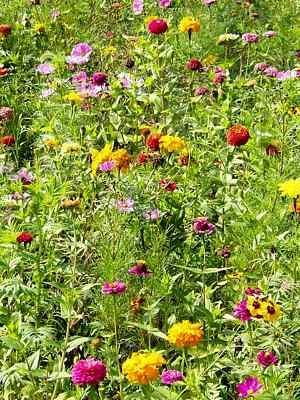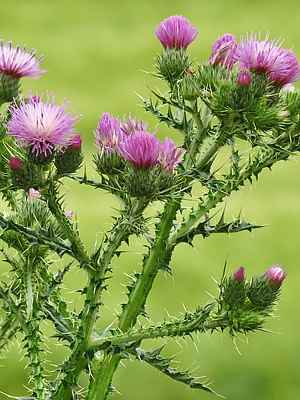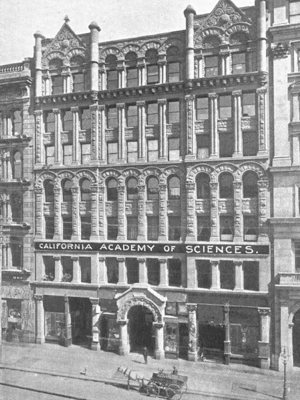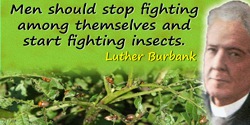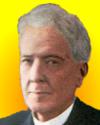 (source)
(source)
|
Luther Burbank
(7 Mar 1849 - 11 Apr 1926)
American naturalist and horticulturist who was a pioneer of plant breeding. At age 21, he produced the the Burbank potato. Thus he began a 55 year career, prodigiously producing useful varieties of fruits, flowers, vegetables, grains, and grasses.
|
How to Produce New Flowers
By LUTHER BURBANK
Read before the Pacific States Floral Congress,
California State Floral Society, Academy of Sciences, San Francisco (14 May 1901)
[p.10] Who does not love flowers? For whom will not flowers make more sunshine? Flowers from the hands of a loved one,—what sweeter, sunnier gift can be thought of? Flowers speak to us of poetry, music, life and love.
Flowers always make people better, happier and more hopeful, they are sunshine, food and medicine to the soul and can never be taken in overdoses.
In this paper I shall try not to burden you with any dry, scientific facts, and if any of them should appear you may rest assured that it is because in the words of Mark Twain, “They simply stew out of me unconsciously.” I wish to tell you simply just how to proceed in the production of new types of flowers and the improvement of the older and well-known ones.
THE PLASTICITY OF PLANT FORMS
The chief work of the botanists of yesterday was the study and classification of dried, shriveled plant mummies whose souls had fled, rather than the living plastic forms. They thought their classified species were more fixed and unchangeable than anything in heaven or earth that we can now imagine.
We have learned that they are as plastic in our hands as clay in the hands of the potter or color on the artist's canvas, and can readily be molded into more beautiful forms and colors than any painter or sculptor can ever hope to bring forth. There is not one weed or flower, wild or domesticated, which will not sooner or later respond liberally to good cultivation and persistent selection. The changes which can be wrought with the most plastic forms are simply marvelous, and only those who have seen this regeneration transpiring before their very eyes can ever be fully convinced.
REQUIREMENTS OF PLANT IMPROVEMENT
It takes time, skill and patience, of course. What valuable work is accomplished otherwise? These profound changes in plants go on quietly as do all the great, beneficent upbuilding forces of nature. No powder is burned, no big guns brought forth, no martial music is heard, for they are destroyers not producers. The beneficent forces of nature are, like truth itself, quiet but persistent and all powerful.
What occupation can be more delightful than adopting the most promising individual from among a race of vile, neglected orphan weeds with settled hoodlum tendencies, down-trodden and despised by all, and gradually lifting it by breeding and education to a higher sphere. To see it gradually change its spawling habits, its coarse, ill-smelling foliage, its insignificant blossoms of dull color to an upright plant with handsome, glossy, fragrant leaves, blossoms of every hue and with fragrance as pure and lasting as could be desired? In the more [p.11] profound study of the life and habits of plants, both domesticated and wild, we are surprised to see how much they are like children. Study their wants; help them to what they need; be endlessly patient; be honest with them, carefully correcting each fault as it appears, and in due time they will reward you bountifully for every care and attention and make your heart glad in observing the results of your work.
Weeds are weeds because they are jostled, crowded, cropped and trampled upon, scorched by fierce heat, starved or perhaps suffering with cold, wet feet, tormented by insect pests or lack of nourishing food and sunshine. Most of them have opportunity for blossoming out in luxurious beauty and abundance. A few are so fixed in their habits that it is better to select an individual for adoption and improvement from a race which is more pliable. This stability of character cannot often be known except by careful trial, therefore members from several races at the same time may be selected with advantage; the most pliable and easily educated ones will soon make the fact manifest by showing a tendency to “break" or vary slightly or perhaps profoundly from the wild state.
Any variation should be at once seized upon and numerous seedlings raised from this individual.
In the next generation one or several, even more marked variations will be almost certain to appear, for when a plant once wakes up to the new influences brought to bear upon it the road is opened for endless improvement in all directions, and the operator finds himself with a wealth of new forms which is almost as discouraging to select from as in the first place it was to induce the plant to vary in the least, and now comes the point where the skill of the operator is put to the severest test.
THE IMPORTANCE OF SELECTION
When a wild plant has been induced to change its old habits, fixed by ages of uniform environment, it needs some one with a steady hand at the helm to guide its bark into a new and more prosperous port and into a condition of refinement and beauty sufficient to adorn any occasion.
Besides a selection another important factor in the production of new flowers is in the amalgamation of the best qualities of two or more species or varieties by crossing, but crossing quite as often produces plants with all the faults of both parents as all their virtues. Its chief value is in breaking up the fixed character of any type. Then by careful selection of the best through several generations more advancement may often be made in a few years than could be made in a century if the fixed type had not been broken up by the crossing of types or species. But crossing is of little use unless followed by very careful selections of the best, and not only the best, but a certain type of the best should be kept in view and all plants which do not closely follow the chosen type should be weeded out as soon as their vagrant character appears, thus in annuals fixed types may be produced, but in perennials, [p.12] when a splendid type appears it can generally be multiplied to any extent by budding, grafting or from cuttings, thus avoiding the care and time required in making this character permanent as with annuals.
AN ILLUSTRATION
We say to our own Miss Golden Cup or Miss Eschscholtzia, as the bon-ton call her, “This beautiful dress of bright golden hue which you have always worn on all occasions is very becoming to you, and exceedingly appropriate to this land of perpetual sunshine, but, Miss Queen Golden Cup, if you will sometimes adorn yourself with a dress of white, pale cream, pink or crimson we could love you still better than we do.”
Now, Miss Eschscholtzia, though having her family tastes and characteristics very thoroughly fixed, still belongs to the great Papaver race, which has often shown itself willing to adapt itself to the discipline of new conditions, even at first distasteful in the extreme.
So, after taking Miss Golden Cup into our gardens and constantly making these suggestions to her, she hesitatingly consents to don a dress a shade lighter in color: and then lighter still, until now we have her not only in dresses of gold, but in deepest orange, light and dark shades of cream, purest showy white, or all these combined and by constant selection and various educational influences in this line she will adorn herself in a dress of almost any color which may be desirable and at the same time seems to take the greatest pleasure in improving herself in every grace of form and feature.
ANOTHER ILLUSTRATION
We often suddenly meet Mr. Cactus or Mr. Thistle, and sometimes almost lose our temper on account of their irascible tendencies and punctilious reception, but after regaining our composure we say: “Mr. Thornicuss! Ah, pardon me, Mr. Thistle, we can never enjoy your company while you wear all those tacks, pins and needles; you would look much better if you would drop those ugly thorns; they cost you too much to produce and stick all over yourself, peaked end out, and no doubt they make you almost as unhappy as they do your neighbors. At heart you are a splendid fellow. All the slugs, bugs, birds and animals like you; you are good enough to eat. Yes, I know you are obliged to wear those pins, clothes from head to foot, just because you have such a good, tender, juicy heart, which all the two, four and six-footed marauders like.”
Now, if we invite Mr. Thistle into our gardens and patiently and earnestly teach and thoroughly convince him that all the marauding animals shall be kept out, it will not be very long before some member of his tribe will see fit to partially discard some of those exasperating pins and needles and put on a more civilized suit, of clothes, and by further careful selections from this one varying individual others are produced which are absolutely spineless, to remain so as long as the marauding animals do not disturb them, often becoming useful [p.13] members of our parks and gardens. It is great effort on the part of the plant to produce all these spines, and when this effort is made unnecessary the plant will at once become more docile and pliable, and can be easily led into almost any useful occupation in which plants are employed.
Roses, blackberries, raspberries and gooseberries can also be made as perfectly thornless as strawberries or apples are by the same education and individual selection. At present, however, the authors of new fruits and flowers are fully employed in improving the size, abundance and perfection of form, color and fragrance in flowers and the abundance and lusciousness of fruits, otherwise the thorns would have been eliminated long ago.
MENDING NATURE
Everything which we now have in fruits, flowers, vegetables or grains has been brought to its present state of perfection, by the same education and selection, which is only a turning of the forces of nature into new channels for the welfare of mankind. By the patient application of these educative influences the wheat, corn, rice and other plants which were once wild grasses, have been induced to produce enormous quantities of nutritious eggs, which, when divested of their unnutritious shells or coverings, furnish food for all the earth.
Our fruits and flowers have all traveled the same road, ever onward and upward, under the tender care of the horticultural missionaries of the past— forerunners of civilization—who really knew but very little of the possibilities of plant life or the transcendant forces which nature has placed in the keeping of plants for the growth and uplifting of humanity. Plant life is so common all about us that we seldom stop to think that almost every good we have on earth is produced by their silent but all-powerful forces.
Only lately have we learned how readily we can train, combine and guide these forces into endless useful and beautiful forms, which even the imagination cannot conceive. The careful investigator along these lines is often amazed at the wealth of new forms, new qualities, and new colors of fruits and flowers which nature lavishly showers upon him, seemingly almost by the asking, when once we know the way and apply ourselves to it. It takes, however, an intimate knowledge of the affinities of plants, a keen perception of the useful forms when produced, a sweet and abiding patience which knows no end, and to carry on extensively the purse of a multimillionaire. But any one can take in hand any one plant and in a few years produce wonders in variation and improvement, and at the same time be gaining patience, knowledge, health, happiness and personal discipline, all of which are far above price, and if a new and beautiful flower or fruit is produced which all the world wants, what a happiness has been secured, not only for the author but an added legacy of sunshine and health for all the world for all time to come. Are not these inducements enough to make one wish to help [p.14] on this great work of world-wide import, impelling upward not only the destinies of tribes and nations, but the broader destinies of all mankind?
Santa Rosa, Cal.
- Science Quotes by Luther Burbank.
- 7 Mar - short biography, births, deaths and events on date of Burbank's birth.
- New Creations in Plant Life: An Authoritative Account of the Life and Work of Luther Burbank, by W. S. Harwood. - book suggestion.

